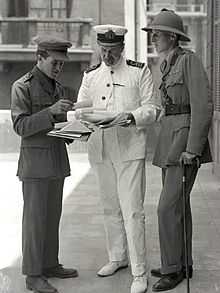Arab Bureau

The Arab Bureau was a section of the Cairo Intelligence Department during the First World War. According to a Committee of Imperial Defence paper from 7 January 1916, the Arab Bureau was established to "harmonise British political activity in the Near East...[and] keep the Foreign Office, the India Office, the Committee of Defence, the War Office, the Admiralty, and Government of India simultaneously informed of the general tendency of Germano-Turkish Policy."[1]
History
Beginnings

It was constituted on the initiative of Mark Sykes who, in December 1915, reported to London that, in a recent tour of the Middle East from Egypt to India, he had discovered that the German and Turkish Governments were widely distributing anti-British wartime propaganda. Sykes was concerned because British command posts in the Middle East were generally uncooperative and thus far unable to produce counterpropaganda. Sykes proposed the creation of a London office under his auspices to gather, filter, and distribute intelligence on the German and Turkish Middle East policy and "co-ordinate propaganda in favour of Great Britain among non-Indian Moslems."[2]
Support
Sykes' proposal was welcomed by Gilbert Clayton, the director of civilian and military intelligence in Egypt and Sudan. Clayton believed that such an office might not only discover and counter enemy propaganda but be capable of overseeing a wider collection of political and military information regarding the Middle East and in turn produce easily understood reports to inform policymaking in Cairo and London toward the Ottoman Arab territories.[3]
Opposition
Clayton's preference for locating the Arab Bureau in Cairo met with resistance from the Indian Government (Charles Hardinge) and the India Office (Austen Chamberlain), who did not want interference in their control of territories around the Persian Gulf and particularly the Iraq provinces that they planned to occupy and cultivate for grain production for India. Newly discovered oil deposits located around the North Gulf brought further attention to the region. But the director of Naval Intelligence in Britain, Captain Reginald 'Blinker' Hall, supported Clayton's concept and urged government approval.
Establishment
The result was a compromise. In January 1916, the Arab Bureau was established as a section of Sudan Intelligence in Cairo, under the authority of the high commissioner of Egypt (Henry McMahon) and the Foreign Office, and staffed by Middle East experts from military intelligence, Egypt Force who shared Clayton's outlook.[4]
Staff
Gilbert Clayton was named head or "chief" of the Arab Bureau. David Hogarth, a naval intelligence officer, was acting director of the Arab Bureau and Kinahan Cornwallis his deputy. Herbert Garland, George Ambrose Lloyd, George Stewart Symes, Philip Graves, Gertrude Bell, Aubrey Herbert, and Thomas Edward Lawrence were also part of the Arab Bureau.
In 1920, Garland was appointed director, under High Commissioner to Egypt Lord Allenby.[5]
References
- ↑ Committee of Defence Paper, "Establishment of an Arab Bureau in Cairo", 7 January 1916, FO882/2 ArB/16/4, quoted in Polly Mohs, Military Intelligence and the Arab Revolt (New York, 2008) p. 34.
- ↑ Memorandum by Sykes, 23 December 1915, British Foreign Office 882/2 ARB/15/4, fos 1-14. quoted in Polly Mohs, Military Intelligence and the Arab Revolt (New York, 2008), p. 33.
- ↑ Polly Mohs, Military Intelligence in the Arab Revolt, (New York, 2008), p. 34.
- ↑ Polly Mohs, Military Intelligence in the Arab Revolt, (New York, 2008), p. 34-36.
- ↑ Garland, Herbert; Bannister, C. O. (1927). Ancient Egyptian Metallurgy. Charles Griffin & Company.
Bibliography
- A Peace To End All Peace , David Fromkin, Avon Books, New York, 1990
- Arabian Personalities of the Early Twentieth Century with a new Introduction by Robin Bidwell (reprints from Bureau's Handbooks ) The Oleander Press 1986 ISBN 0-906672-39-2
- Military Intelligence and the Arab Revolt: The First Modern Intelligence War , Polly Mohs, Routledge, New York, 2008
- The Arab Bureau, Bruce Westrate, Penn State Press, 1992